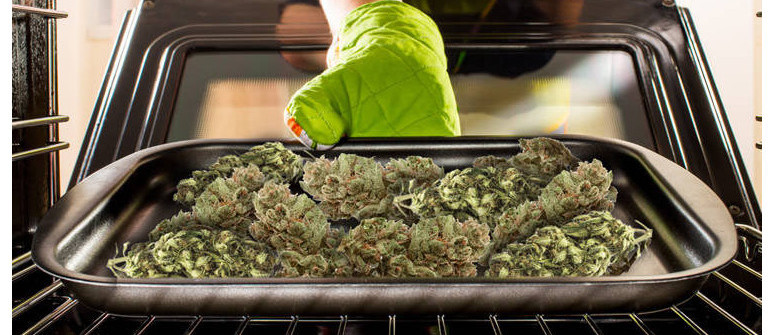How to decarb your weed and why is it a must?

The process of decarboxylation alters the chemistry of your cannabis. Without it, the herb would not get you high.
It is fully recommended to decarboxylate your marijuana before cooking with it to achieve the strongest psychoactive effects and medicinal potential. Doing this beforehand will be a safeguard against wasting any herb that is not appropriately decarbed during cooking.
HOW TO DECARB YOUR CANNABIS BEFORE COOKING
- Start by preheating the oven to 115 degrees Celsius/240 degrees Fahrenheit.
- Take the amount of cannabis you have chosen to use and start to break it up into smaller chunks.
- Scatter the pieces onto a tray topped with baking paper and place into the oven.
- Bake your weed for between 30-40 minutes and give it a stir every 10 minutes to make sure it cooks evenly.
- After the suggested period of time the cannabis should start to sport a darker brown colour, it should then be taken out and left to cool.
Any temperature above 204.4 degrees Celsius/400 degrees Fahrenheit will burn off the terpene content and reduce the quality of the herb, along with its particular flavors and smells that will bring desired recipes to life.
WHAT DOES DECARBOXYLATING YOUR WEED DO?
It is important to realise that the chemical constituents within raw cannabis are not necessarily active. A method of heating known as decarboxylation ('decarb') is needed to convert molecules in the raw plant into active cannabinoids.
For example, there is surprisingly little to no THC within raw cannabis plants. However, depending on the strain there is most likely an abundance of THCA, known as tetrahydrocannabinolic acid.
When heat is applied THCA molecules lose a carboxyl group and are transformed into THC which is able to bind to endocannabinoid receptors in the brain and body, resulting in a psychotropic high.
This is why eating raw cannabis will not get you high, although there are still associated health benefits with consuming the raw plant in salads, juices and so on. The reason smoking the herb dispenses a psychoactive effect is because it is adequately heated and so THCA is converted to THC is a very short and intense time frame, delivering newly formed THC into your air ways, blood stream and brain.
Decarboxylation is also required to transform CBDA into CBD which increases the bio-availability of the molecule and helps it to work more immediately in the body.
We understand that cooking and consuming marijuana is an extremely exciting process and that this excitement conjures the tendency to get things done fast. Resisting the urge to rush will actually cultivate better results and a stronger end product. Decarboxylation at a lower temperature will lengthen the process but will keep beneficial chemicals found in weed, called terpenes, intact.
Growing, cooking and consuming cannabis is most certainly not exclusively about cannabinoids.
Terpenes are the molecules that are responsible for the diverse range of smell and tastes that can be experience in different marijuana strains from lemony zest and berry to pineapple. Not only do they add sensory pleasure to the picture, they also harbour different medicinal qualities and synergise with THC to create different psychoactive effects.
.jpg)
.jpg)

.jpg)
